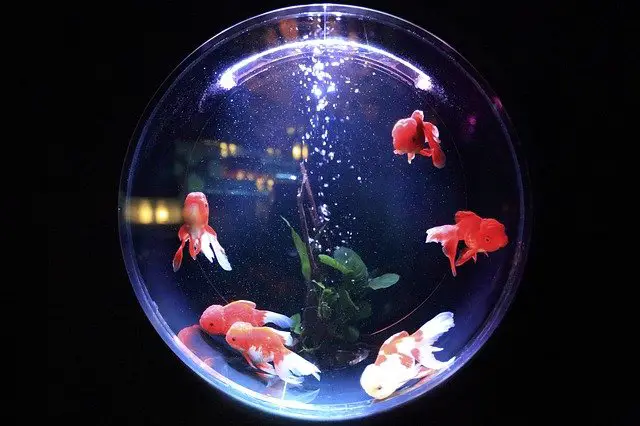The Clown fish is a really good choice for your first saltwater pet. They are hardy and so much easier to take care of than other saltwater fish choices at your local pet store.
As long as you keep a close eye on the water parameters ensuring your saltwater temperature, salinity and PH are good then your fish should survive for quite some time.
Of course you must cycle your tank beforehand ensuring the nitrogen cycle has run its course, this article assumes you have already done so. If you are not sure what the Nitrogen Cycle is then I Suggest you go read my article on the topic. The Aquarium Nitrogen Cycle and why it is so important.
Do Clown Fish Need Saltwater?
Yes Clownfish require saltwater to survive. Their natural habitat is in the ocean. The ocean is saltwater. Make sure you do not place Clown fish in a freshwater aquarium or you will kill your fish. Clownfish need to be in a saltwater tank plain and simple.
Clownfish Tank Requirements and Tank Set Up
What size tank do you need for Clownfish?
Clown fish by nature are not into swimming long distances. They like to swim up and down and outward a bit and you will rarely catch them swimming a long distance horizontally. This makes them great candidates for a modest size tank. One word of caution I would give is do not place a clownfish in a small tank just because it might be okay.
I would still purchase as big of an aquarium as possible. Smaller aquariums tend to be harder to take care of when considering things like water parameters. Believe it or not they are also harder to clean. If you are going to have a couple of clowns I would opt for a tank that is at least 30 gallons (113 liters) or so.
If you want an aquarium recommendation for 1 or 2 clown fish then check out this one on Amazon. Perfect tank size for a Clownfish.
What Kind of a Tank Does a Clownfish Need?
If you can afford to purchase an acrylic tank I would recommend doing so. The colors inside the tank will pop as acrylic tanks seem to be clearer than glass if you can believe that.
Typically acrylic tank kits come with LED lighting but if you don’t have an LED light that would be another investment I would recommend as the LED light will bring out the orange white and black in your Clownfish.
How to Set Up a Saltwater Tank for Clownfish?
Clown fish do not need a tank filled with all kinds of structures however if you chose to have a tank filled with rock it would be alright because clowns natural habitat is around coral reefs. The difference is that in the ocean if a fish chooses to it can swim out into the wide open abyss of the ocean, where in a tank it cannot do this so not filling it up too much is okay.
When housing Clown fish assuming you will not have any anemones to start with you must make sure the fish have a few spots they can hide in if they feel they need to. As you get more advanced in the aquarium hobby you will probably want to try an Anemone in your tank but for now I would work on mastering keeping a fish only aquarium.
For hiding places you can place rock in a way that there are small cave like features or purchase aquarium decorations that are made for fish to hide in which is an even easier choice. It just doesn’t look as natural as stacking rock in my opinion.

Proper Water Parameters for a Clown Fish Tank
Using a premium aquarium salt mix for your water is extremely important. Purchase yourself a good salinity meter as well. Specific gravity should be in the range of 1.021 and 1.026 ( 29 to 35 PPT). You will find these numbers on your salinity meter.
PH in your Clown fish saltwater aquarium should be in the range of 8.0 to 8.4.
The best water temperature for your salt tank should be in the range of 73 Fahrenheit to 80 Fahrenheit which is approximately 22.8 Celcius to 27 Celcius.
Water flow in your Clownfish tank should be moderate. Have enough flow to provide a bit of a current but nothing overwhelming for the fish.
The lighting in your fish only salt tank does not have to be super bright. Whatever LED lights come with the tank will be sufficient until you start getting into Anemones and maybe even corals.
If you still need the equipment to perform these measurements you should have a look at my recommended aquarium supplies page to make sure you get everything necessary for a successful tank.
A Protein Skimmer is commonly used in salt water aquariums however if you are performing water changes frequently and have fish only in your tank then you can get away without having to use a Protein Skimmer.
How Long do Clownfish Live in a Tank?
The life expectancy for a Clownfish will differ slightly from species to species however most Clown fish will survive in a home aquarium (in captivity) anywhere from 3 to 5 or more years all dependant on how well you can take care of your pet.
In its natural habitat the Clown fish will live longer than 5 years up to somewhere around 8 or so years.
How Much to Feed a Clownfish and What Do Clownfish Eat?
Feeding Clown fish is easy. These fish are not overly picky and will eat most foods made for saltwater fish as in flake and pellet format.
Mysis shrimp and Brine shrimp can be added to the diet to provide some variety as well as ensuring the fish are getting all the nutrients possible. The goal is to give them a varied diet fit for omnivores and carnivores so they will live a long and healthy life.
When feeding your fish make sure to give only enough so that after 2 or so minutes there is no evidence of food floating in the water. If there is food floating around or found on the bottom of the tank then you are over feeding.
It is important to know that over feeding is not treating your fish. You will kill the fish as overfeeding can and will cause issues with the water parameters spiking making the water dangerous for the fish.
Feed your Clown fish no more than once a day and every once in while you can skip a day from feeding them if you feel you might be giving to much food. The fish can last for days without suffering so do not worry about that.
What are Good Clownfish Tank Mates?
Here is where a lot of new aquarium hobbyists get it wrong. You must research compatibility  between fish species before placing them in a tank together or you risk putting a fish or all the other fish in danger of being killed by an aggressive fish.
between fish species before placing them in a tank together or you risk putting a fish or all the other fish in danger of being killed by an aggressive fish.
I would suggest though that if you are brand new to the hobby that you focus on just keeping the Clownfish alone in your tank for a few months before adding anything else. I feel you should be able to master caring for one species of fish before you move on to the next one. Otherwise it could blow up on you costing you money and time and the lives of your pet fish.
Suitable tank mates for a Clownfish include but are not limited to:
Damsel fish, Tangs, Blennies, Gobies, Angelfish, Puffers, Box fish, Wrasses.
When you get to the stage of purchasing a new species of fish make sure to do a bit of research on whether your new fish will get along with Clowns.
I will give you a word of caution if you ever think of placing a different species of Clown in with your existing fish. The problem right away is that your existing fish will be territorial. It is best to stick with the same species of clown unless you have a massive aquarium over 100 gallons where everyone can coexist.
Do clownfish have one mate for life?
Yes Clownfish typically have one mate for life. This only changes when the dominant make changes into a female when necessary. In a small tank if you are lucky enough to have one female and one male then chances are they will mate for life.

Clownfish Temperament
Clownfish are for the most part calm and peaceful fish. They will fight if another Clownfish tries to invade their host anemone or if there is a pair in the tank and you introduce another. There is the possibility of some fighting going on.
How Do Clownfish Protect Themselves?
Clownfish will protect themselves by retreating into an anemone or into a crevice in the rocks. Anemone’s have stinging tentacles that have no effect on a Clownfish but will hurt other species of fish. Clownfish have a mucus covering their bodies that protects them from the stinging tentacles. The Clownfish and Anemone live in a symbiotic relationship.
The question often arises whether an Clownfish can survive without an anemone and the answer is yes they can however they would always prefer a good host for comfort and protection.
How Does a Clownfish Change Gender?
All Clownfish are born male. Clownfish are sequential hermaphrodites. This means they can change sex when necessary. Usually there is only one female and a group of males that live together. When the female either dies or leaves then the most dominant male fish turns into the female. Strange but true.
Do Clownfish Sleep at Night?
If you turn the aquarium lights off at night then your fish will go to sleep. If you were to sneak up to your tank in the middle of the night and turned the lights on you would find your fish either nestled in an anemone or in the crevice of rocks or other hiding place. You might even find the fish lying on the bottom of the tank. Yes Clownfish sleep at night.
If you left the aquarium lights on all night the fish would probably not sleep and would eventually become irritated and stressed. Extended periods of light could eventually cause death of the fish.
The information I have given you above about setting up a tank for a Clownfish should be more than enough for you to have a successful aquarium running for years to come.
If you are interested in learning about other saltwater fish then check out my article on Perfect tank size for a Clownfish
Recommended Posts
What Saltwater Fish Can Live in a 5-Gallon Tank
Do Clownfish Attack Other Fish?
Reef Safe Fish for a 55 Gallon Tank?
Can a Black Clownfish Mate with an Orange One?






